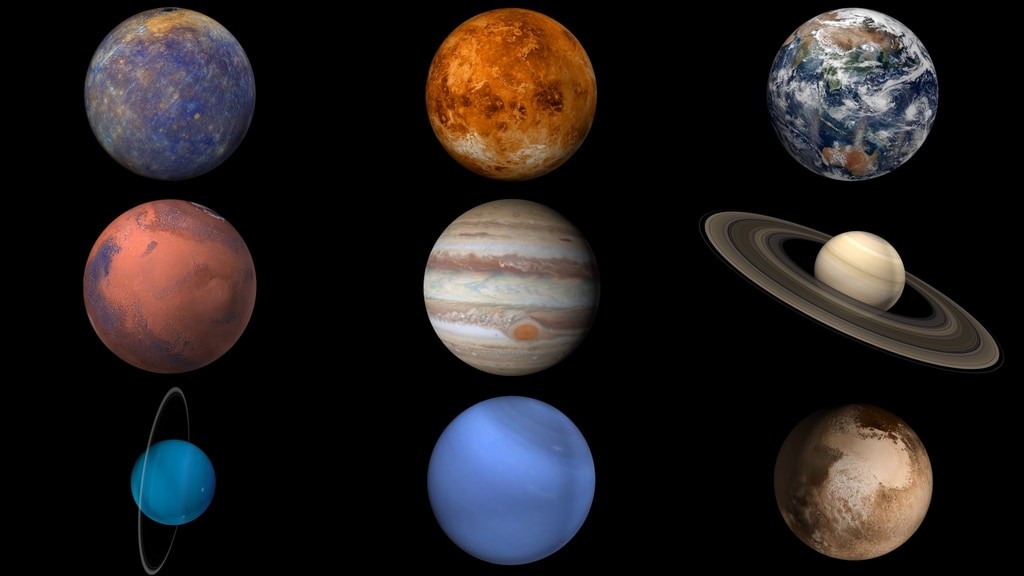Pluto’s gravity compared to Earth is significantly weaker, approximately 6% of Earth’s gravitational pull. Explore the fascinating world of this dwarf planet with COMPARE.EDU.VN, examining its gravity, size, and other unique characteristics. Discover why Pluto was reclassified and delve into the mysteries of this icy world located in the distant Kuiper Belt.
1. What is Pluto? Introduction to a Dwarf Planet
Pluto, a complex and mysterious world located in the distant Kuiper Belt, boasts mountains, valleys, plains, craters, and glaciers. Once considered the ninth planet of our solar system, it was reclassified as a dwarf planet in 2006 by the International Astronomical Union (IAU) following the discovery of similar objects deeper within the Kuiper Belt. This reclassification stems from the 2006 IAU Resolution, which defines a dwarf planet as an object orbiting the Sun, possessing sufficient mass to achieve hydrostatic equilibrium (a nearly round shape), but lacking the ability to clear its orbit of other debris.
1.1 What are Pluto’s Key Characteristics?
Pluto is small, with a diameter of only about 1,400 miles (2,380 kilometers), roughly half the width of the United States. It resides approximately 3.6 billion miles (5.8 billion kilometers) from the Sun and features a thin atmosphere primarily composed of nitrogen, methane, and carbon monoxide. The average temperature on Pluto is a frigid -387°F (-232°C), rendering it inhospitable to life as we know it.
1.2 What about Pluto’s Moons?
Pluto is accompanied by five known moons, with Charon being the largest. Charon’s size is about half that of Pluto, making it the largest satellite relative to its host planet in our solar system. The close proximity and size relationship between Pluto and Charon have led to them being often referred to as a “double planet.”
1.3 What Important Missions Has Pluto Been Subject To?
NASA’s New Horizons spacecraft is the only one to have explored Pluto up close. In 2015, it conducted a flyby of the dwarf planet and its moons, providing valuable data and images.
2. Why Is Pluto Called Pluto? Unveiling the Namesake
Pluto owes its name to an 11-year-old girl named Venetia Burney. In 1930, Venetia, residing in Oxford, England, suggested to her grandfather that the newly discovered celestial body be named after the Roman god of the underworld. Her grandfather then passed the suggestion on to the Lowell Observatory, which ultimately selected the name.
2.1 Who Was Venetia Burney?
In a 2006 interview with NASA, Venetia recounted offering the name “Pluto” during breakfast with her mother and grandfather on March 14, 1930, after her grandfather, Falconer Madan, announced the discovery of the ninth planet.
2.2 Why Was This Name Significant?
Alan Stern, the principal investigator for NASA’s New Horizons mission, emphasized the historical significance of Venetia’s contribution, stating that “Venetia’s interest and success in naming Pluto as a schoolgirl caught the attention of the world and earned her a place in the history of planetary astronomy that lives on.”
2.3 What Is The Origin Of The Name?
Dr. Elizabeth Vandiver, chair of the Department of Classics at Whitman College, clarified the origins of the name, explaining that “Pluto is the name of the Roman god of the underworld, equivalent to the Greek Hades.”
3. What Is The Possibility of Life on Pluto? Exploring the Potential
The surface conditions of Pluto are extremely cold, making the existence of life as we know it unlikely. At such low temperatures, water, essential for life, behaves like rock. However, Pluto’s interior is warmer, and some scientists speculate that a deep ocean might exist beneath the surface.
4. How Big Is Pluto? Assessing Size and Distance
Pluto has an equatorial diameter of approximately 1,477 miles (2,377 kilometers), about one-fifth the width of Earth.
4.1 How Far Is Pluto From The Sun?
At an average distance of about 3.7 billion miles (5.9 billion kilometers), Pluto is roughly 39 times farther from the Sun than Earth. Sunlight takes about 5.5 hours to reach Pluto from the Sun.
4.2 How Bright Is The Sun on Pluto?
If you stood on Pluto’s surface at noon, the Sun would appear 1/900th as bright as it does on Earth, roughly 300 times brighter than a full moon. There is a brief period each day near sunset on Earth when the light intensity matches that of midday on Pluto, NASA calls this “Pluto Time.”
5. How Does Pluto Move? Analyzing Orbit and Rotation
Pluto’s orbit around the Sun is notably different from that of the planets. It is both elliptical (oval-shaped) and inclined. Pluto’s orbit, lasting 248 Earth years, takes it as far as 49.3 astronomical units (AU) from the Sun and as close as 30 AU. One AU is the average distance between Earth and the Sun, approximately 93 million miles (150 million kilometers). On average, Pluto is 3.7 billion miles (5.9 billion kilometers) from the Sun, which is 39 AU.
5.1 When Was Pluto Closest To The Sun?
From 1979 to 1999, Pluto was near its perihelion, the point in its orbit closest to the Sun. During this period, Pluto was actually closer to the Sun than Neptune.
5.2 How Long Is A Day on Pluto?
One day on Pluto lasts approximately 153 hours. Its rotational axis is tilted at 57 degrees relative to its orbital plane around the Sun, causing it to spin almost on its side. Pluto also exhibits retrograde rotation, spinning from east to west, similar to Venus and Uranus.
6. What Moons Orbit Pluto? Investigating its Satellites
Pluto has five known moons: Charon, Nix, Hydra, Kerberos, and Styx. This moon system is believed to have originated from a collision between Pluto and another similarly sized body early in the solar system’s history.
6.1 What Is Unique About Charon?
Charon, the largest of Pluto’s moons, is approximately half the size of Pluto itself. This makes it the largest satellite relative to its host planet in our solar system. It orbits Pluto at a distance of only 12,200 miles (19,640 kilometers). For comparison, our Moon is 20 times farther from Earth. Pluto and Charon are often referred to as a double planet due to their relative sizes.
6.2 What Is Tidal Locking?
Charon’s orbit around Pluto takes 153 hours, which is the same time it takes Pluto to complete one rotation. This means that Charon appears to hover over the same spot on Pluto’s surface and never rises or sets. The same side of Charon always faces Pluto, a state known as tidal locking.
6.3 What Are the Other Moons Like?
Pluto’s other four moons are much smaller, with diameters less than 100 miles (160 kilometers). They are also irregularly shaped, unlike the spherical Charon. Unlike many other moons in the solar system, these moons are not tidally locked to Pluto. They spin and do not keep the same face toward Pluto.
6.4 How Did Pluto’s Moons Get Their Names?
Pluto’s moons are named after mythological figures associated with the underworld. Charon is named after the boatman who ferries souls across the river Styx in the underworld, as well as honoring Charlene, the wife of discoverer James Christy, who was nicknamed Char. Nix is named after the goddess of darkness and night, who is also the mother of Charon. Hydra is named after the nine-headed serpent that guards the underworld. Kerberos is named after the three-headed dog of Greek mythology, also known as Fluffy in the Harry Potter novels. Styx is named after the mythological river that separates the world of the living from the realm of the dead.
7. Does Pluto Have Rings? Searching for Orbital Debris
Currently, there are no known rings around Pluto.
8. How Did Pluto Form? Understanding its Origins
As a dwarf planet, Pluto is a member of the Kuiper Belt, a disc-like zone beyond Neptune’s orbit. This region is home to thousands of miniature icy worlds that formed early in the history of our solar system, approximately 4.5 billion years ago. These icy, rocky bodies are known as Kuiper Belt objects, transneptunian objects, or plutoids.
9. What Is Pluto Made Of? Examining its Structure
Pluto is about two-thirds the diameter of Earth’s Moon and likely consists of a rocky core surrounded by a mantle of water ice. Its surface is coated with exotic ices such as methane and nitrogen frost. Due to its low density, Pluto’s mass is about one-sixth that of Earth’s Moon.
10. What Does Pluto’s Surface Look Like?
Pluto’s surface is characterized by mountains, valleys, plains, and craters. The temperature on Pluto can range from -375 to -400 degrees Fahrenheit (-226 to -240 degrees Celsius).
A high-resolution image of Pluto’s surface captured by the New Horizons mission, showcasing its diverse terrain, including the smooth, icy plains of Sputnik Planitia.
10.1 How Tall Are Pluto’s Mountains?
Pluto’s tallest mountains range from 6,500 to 9,800 feet (2 to 3 kilometers) in height. These mountains are primarily composed of water ice, often coated with frozen gases such as methane. Long troughs and valleys, extending up to 370 miles (600 kilometers), further enhance the intriguing features of this distant dwarf planet.
10.2 What About Impact Craters?
Craters, some as large as 162 miles (260 kilometers) in diameter, are scattered across Pluto’s landscape, with some showing signs of erosion and filling. This indicates that tectonic forces are slowly reshaping Pluto’s surface.
10.3 What Are The Plains Like on Pluto?
The most prominent plains observed on Pluto appear to be composed of frozen nitrogen gas and lack craters. These plains exhibit structures that suggest convection, with blobs of material circulating up and down.
11. What Is Pluto’s Atmosphere Like? Analyzing its Gaseous Envelope
Pluto possesses a thin, tenuous atmosphere that expands as it approaches the Sun and collapses as it moves farther away, similar to a comet. Molecular nitrogen is the primary constituent, with detected molecules of methane and carbon monoxide.
11.1 How Does Pluto’s Atmosphere Change?
When Pluto is close to the Sun, its surface ices sublimate, transitioning directly from solid to gas, and temporarily form a thin atmosphere. Due to Pluto’s low gravity, approximately 6% of Earth’s, its atmosphere extends much higher in altitude than our planet’s atmosphere.
11.2 How Does Distance Affect Pluto’s Atmosphere?
As Pluto travels farther from the Sun, it becomes much colder. During this time, the majority of the planet’s atmosphere may freeze and fall to the surface as snow.
12. Does Pluto Have A Magnetosphere?
It is currently unknown whether Pluto possesses a magnetic field. However, its small size and slow rotation suggest that it likely has little to no magnetic field.
13. Understanding Gravity: What Is Pluto’s Gravity Compared to Earth?
Pluto’s gravity is substantially weaker than that of Earth. Here’s a detailed comparison:
| Feature | Earth | Pluto |
|---|---|---|
| Gravity | 9.8 m/s² | 0.62 m/s² |
| Relative Gravity | 100% | ~6% |
| Explanation | This is what we experience every day. | You would weigh only 6% of your weight |


13.1 What Does This Mean?
If you weigh 100 pounds on Earth, you would only weigh about 6 pounds on Pluto. This is due to Pluto’s significantly smaller mass compared to Earth.
13.2 Why Is This Important?
Understanding the gravity of different celestial bodies helps scientists understand the dynamics of the solar system, including how atmospheres are retained and how objects move and interact in space.
14. Exploring Search Intent
To fully address user queries about Pluto, here are five key search intents:
- Informational: Users seeking general information about Pluto’s characteristics and properties.
- Comparative: Users looking to compare Pluto to other celestial bodies, particularly Earth.
- Educational: Students and educators searching for facts and data for research and learning.
- Scientific: Researchers and enthusiasts seeking in-depth scientific information about Pluto’s formation, atmosphere, and geology.
- Visual: Users wanting to see images and visualizations of Pluto and its features.
15. Frequently Asked Questions (FAQ)
1. Why is Pluto no longer considered a planet?
Pluto was reclassified as a dwarf planet because it has not cleared its orbit of other objects, as per the International Astronomical Union’s definition of a planet.
2. How cold is Pluto?
On average, Pluto’s temperature is -387°F (-232°C).
3. Does Pluto have moons?
Yes, Pluto has five known moons: Charon, Nix, Hydra, Kerberos, and Styx.
4. Has a spacecraft visited Pluto?
Yes, NASA’s New Horizons spacecraft flew by Pluto in 2015.
5. What is Pluto’s atmosphere made of?
Pluto has a thin atmosphere composed mostly of nitrogen, methane, and carbon monoxide.
6. How far is Pluto from the Sun?
Pluto is about 3.6 billion miles away from the Sun.
7. What is Pluto’s gravity compared to Earth’s?
Pluto’s gravity is about 6% of Earth’s.
8. Can life exist on Pluto?
The surface of Pluto is extremely cold, making it unlikely that life could exist there.
9. How long is a day on Pluto?
One day on Pluto takes about 153 hours.
10. Is Pluto part of the Kuiper Belt?
Yes, Pluto is a member of the Kuiper Belt, a region beyond Neptune’s orbit containing many icy bodies.
16. COMPARE.EDU.VN: Your Guide to Informed Comparisons
Navigating the complexities of space and planetary science can be daunting. At COMPARE.EDU.VN, we strive to provide clear, objective comparisons that help you understand complex topics. Whether you’re comparing the gravity of different celestial bodies or evaluating the potential for life on other planets, COMPARE.EDU.VN offers comprehensive analyses to guide your understanding.
16.1 Do You Need Help Making Comparisons?
Are you struggling to compare different aspects of planetary science? Do you find it challenging to gather reliable information and make informed decisions? COMPARE.EDU.VN is here to help. We offer detailed comparisons, clear explanations, and unbiased information to empower you with the knowledge you need.
16.2 Get Objective Insights
Visit COMPARE.EDU.VN today to explore our extensive collection of comparisons and make informed decisions with confidence. Let us help you simplify complex topics and discover the information that matters most to you.
For more information, contact us at:
- Address: 333 Comparison Plaza, Choice City, CA 90210, United States
- WhatsApp: +1 (626) 555-9090
- Website: COMPARE.EDU.VN
compare.edu.vn – Making Comparisons Clear and Simple.
